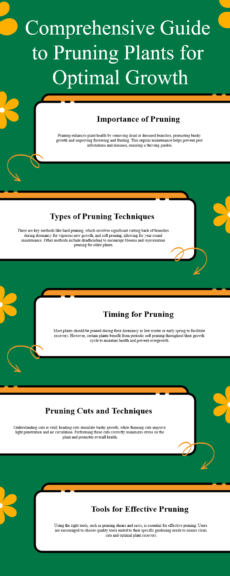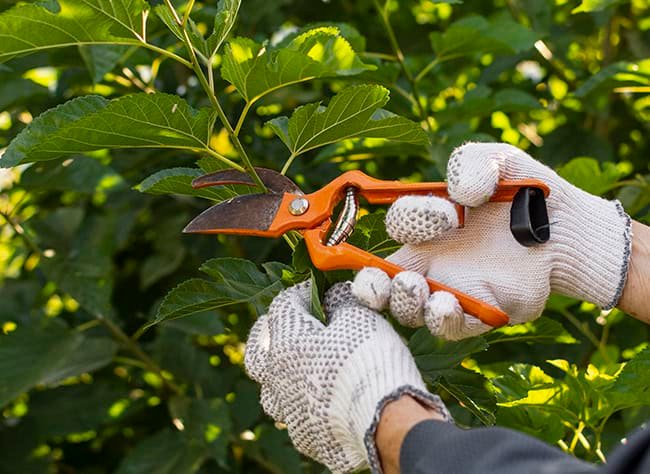Contents
This is a complete guide to pruning plants the right way and promotes better growth and yield. We will learn some useful methods and concepts on pruning or trimming your plants the right way, for better plant growth and boost flowering and fruiting. We will learn useful topics like which season to prune, how to prune, types of Pruning like Hard and Soft Pruning, and lastly which Pruning Tools to choose.

What is Pruning?
Pruning is a crucial task for plant health and maintenance.
Pruning means cutting or trimming plant organs like branches, stems, or even leaves for the sake of your plant’s health and sometimes to maintain plant shape and form.
Pruning is a crucial task in gardening, especially for those aiming to achieve optimal plant performance. By regularly pruning your plants, you can promote bushy growth, which enhances their overall appearance and health, and improve flowering or fruiting, leading to a more abundant harvest. This practice not only encourages new growth but also helps to shape the plant for aesthetic purposes.
Another significant advantage of pruning is its ability to remove damaged, diseased, or infected branches and leaves. These problematic parts can harbor pests and diseases, potentially spreading them to healthy areas of the plant or other nearby plants. By eliminating these compromised sections, you protect your garden from further damage and ensure that your plants can thrive without unnecessary stress. Regular pruning, therefore, plays a key role in maintaining a healthy and vibrant garden ecosystem.

Frequently Asked Questions About Pruning
In this episode, we will briefly look into some questions about pruning like:
- Which season to perform pruning?
- Types of Pruning
- How to Prune and Why?
- Pruning Tools
- And many important concepts and tips on pruning.
Pruning your tree or cutting its branches is more than just a simple task; it is essentially wounding your plant. This process can be likened to a form of plant surgery, akin to human or animal surgery, performed not only to save a plant from disease but also to enhance its appearance, making it look neat and aesthetically pleasing.
During pruning, the act of cutting creates an injury at the point of incision, similar to a surgical wound. It is crucial that this wound heals properly to ensure the tree’s overall health and vitality.
Proper techniques, timing, and aftercare are essential to minimize stress on the plant and promote recovery, allowing it to flourish in the long run. Understanding the significance of each cut can lead to stronger, healthier trees that continue to thrive in your garden or landscape.
So let’s begin:
When to Prune Which Plants?
Let me start with a comparison. The best time to perform surgery on a person is when they are asleep, that’s during anesthesia. This is the same for plants as well. As a general rule for most plants, including flowering and fruiting plants, they need to be pruned, especially hard pruning, while they are in a period of dormancy (that’s when they are asleep or inactive). This usually falls in late winter through early spring, like in the month of January, depending on the climatic zone you live in.
Another reason to perform this surgery in winter is that the healing of the wound is better in this cold season due to many scientific reasons.
But some other plants need to be continuously pruned or trimmed, I mean deadheaded or soft-pruned, to maintain growth and flowering. We shall discuss what is hard pruning, soft pruning, deadheading, etc., shortly. Please read till the end.
Additionally, it’s crucial to disinfect your cutting tools before you start snipping your plants to prevent the spread of diseases. Neglecting this step can lead to infections that might harm your plants. You can easily wipe the blades with any household disinfectant, ensuring that all surfaces are thoroughly cleaned. Alternatively, consider using hydrogen peroxide at 3 or 6 percent concentration, which is an effective and safe option for sanitizing. This solution breaks down quickly and leaves no harmful residues, making it ideal for garden use. Hydrogen peroxide is readily available at your local medical store or pharmacy, so be sure to pick some up before you begin your gardening tasks. Taking these precautions will help promote healthy growth and vibrant plants.
Types of Pruning for House Plants
Here we will learn about Hard Pruning, Soft Pruning, Rejuvenation Pruning, Deadheading, and many other useful tips.

Hard Pruning vs. Soft Pruning
Hard pruning
Hard Pruning or annual pruning, as I discussed earlier, is done in the dormant or inactive growth period of a plant during late winter or early spring. In hard pruning, we cut off most of the plant stems and branches—typically at least 50 percent—to encourage robust new growth during the upcoming growing season.
This practice not only stimulates the plant to produce fresh, healthy shoots but also helps to improve air circulation and sunlight penetration, which are essential for overall plant health.
By removing older, less productive wood, we allow the plant to redirect its energy toward new growth, resulting in a more vigorous and fruitful plant. Additionally, hard pruning can help maintain the desired shape and size of the plant, ensuring it remains aesthetically pleasing in gardens or landscapes.
Soft pruning
Soft pruning can be performed at any time of the year, making it a versatile technique for maintaining plant health. This process involves trimming the plant back to one-third to half of its size, which encourages robust growth. A prime example of this technique is the periodic pruning or trimming of a rose bush, which not only helps shape the plant but also promotes flowering.
Additionally, soft pruning includes a practice known as deadheading. This refers to the removal of dead or dried flowers from a plant that has recently bloomed. By eliminating these spent blooms, you prevent the plant from directing its energy into seed formation, allowing it to instead focus on producing new growth and additional flowers.
It’s important to note that deadheading can sometimes require consistent attention, especially during the peak blooming season, as it enables the plant to thrive and maximize its flowering potential. This proactive approach to plant care can significantly enhance the overall health and aesthetic appeal of your garden.

Soft Pruning or Trimming
How to Prune? And Types of Pruning Cuts?
We will learn two important cuts here: Heading and Thinning Cuts, which can make your plant more bushy and increase flowering and fruiting.
Heading
Heading is the process of cutting or trimming branch tips; the cut is made anywhere on the branch or stem just half an inch above a node where it produces multiple branches, usually two branches from a node, and this process makes your plant more bushy in the long run.
One very important tip here: The cut is to be made at an angle of 45 degrees to allow water to run off. Because if a flat cut is made, water can stay on top of the wound, which increases the chances of fungal or bacterial infection.
It’s also a good idea to seal the wound with some stuff like wax or an antifungal powder or anything – even some recommend fevicol paste.
If you can buy a tree paint or any commercially available pruning sealer, that’s still better. Some experts say it’s better to leave it open and let the plant heal itself, especially for larger trees.
- [Tree Wound Sealer] — Fast, easy, and effective dressing designed to aid in the healing of any kind of pruning cut, graft, or wound.
- [Protect Your Trees] — Our Tree Wound Sealer is specially designed to protect wounds and cuts on trees, allowing them to grow stronger.
Thinning
Thinning is the process of removing entire branches from a main stem by cutting its collar or just outside of the collar. The collar is the area where the branch connects with its main stem. Thinning helps sunlight penetrate the interior foliage and promotes good air circulation, thus avoiding fungal and bacterial growth.
If you are not sure how and when to prune a particular plant, I still suggest that you perform soft pruning at least once during its growth cycle to promote healthy development. Soft pruning involves removing just a few of the outer leaves or stems, which can help encourage new growth without stressing the plant too much.
This gentle approach allows you to maintain the plant’s shape and overall health, making it more resilient to various environmental factors. Remember to assess the specific needs of your plant, as different species may have unique pruning requirements.
You can check my article on Choosing the Right Pruning Tools, which helps you buy the best pruning shears or pruning saw, or whatever your requirement is. The first tool beginners in gardening search for is to buy the best pruning shears. You can check this quick comparison table or read my full review on best hand pruners. Also Reviews on the Best Electric Pruning Shears.
Please, like, share, and comment below with your feedback and queries. Happy Gardening!
Please watch this video tutorial on Pruning Trees below:
Last update on 2025-03-27 / Affiliate links / Images from Amazon Product Advertising API





